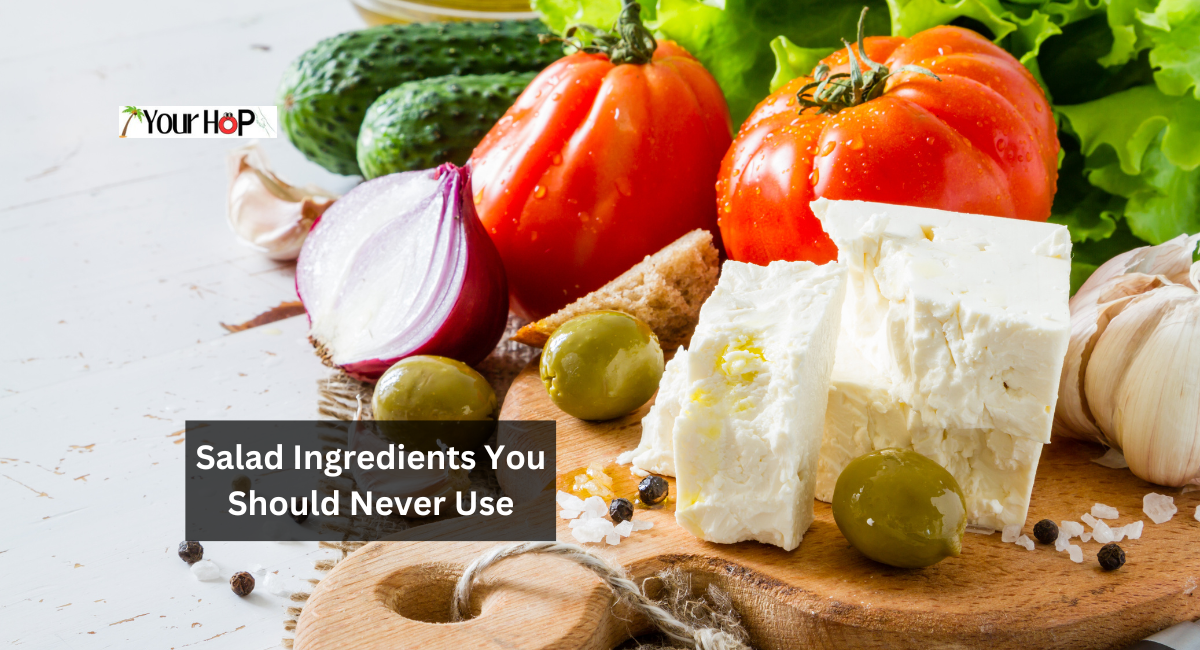Creating a vibrant, nutritious salad is an art form that focuses on using the freshest and healthiest ingredients. However, among the numerous options, some ingredients may jeopardize the essence of a nutritious salad. Certain additions can disrupt the harmony of a perfectly balanced salad, whether due to its questionable nutritional value, potential health risks, or overpowering flavors. Understanding which ingredients to avoid is critical to preserving the integrity and healthfulness of your leafy creation.
This article will review a list of salad ingredients you should avoid, their disadvantages, and healthier alternatives.
Salad Ingredients You Should Never Use
A delicious, hearty salad demonstrates that eating healthy does not have to be a chore. A poorly prepared salad, on the other hand, is unsatisfying and frequently leaves you hungry an hour later. The good news is that making homemade salads is relatively simple—as long as you avoid common pitfalls resulting in your salad being soggy, bland, or both.
Avoiding Salad Ingredients
1. Refined Sugars And Sweeteners
A healthy salad can become a calorie-laden dish by adding refined sugars or high-calorie sweeteners. Candied nuts, sugary dressings, and sweetened dried fruits are common culprits. These additives raise blood sugar and contribute to weight gain.
2. Processed Meats And High-Fat Proteins
Bacon bits, processed deli meats, and high-fat cheeses can significantly increase saturated fat and sodium intake. These ingredients have been linked to a variety of health issues, including heart disease and weight gain.
3. Unhealthy Dressings And Sauces
Creamy dressings with artificial flavors, preservatives, and high-fructose corn syrup are hazardous to a healthy salad. These dressings add extra calories and unhealthy fats to the salad, negating its health benefits.
Health Consequences Of Poor Ingredient Selection
The inclusion of unhealthy ingredients in salads can have serious health consequences. Weight management becomes difficult, and the overall health impact is frequently negative. Furthermore, certain ingredients may pose risks, such as increased cholesterol or digestive issues.
Alternative And Healthier Alternatives
Sweeteners And Substitutes Made From Natural Ingredients
Choose natural sweeteners such as honey or maple syrup. Alternatively, use fresh fruits such as berries or citrus segments to add natural sweetness to your salad.
Sources Of Lean Protein
To maintain a balanced protein intake without excessive fat content, substitute grilled chicken, tofu, beans, or quinoa for processed meats.
Healthy Dressings And Homemade Substitutes
Dressings can be made with olive oil, vinegar, herbs, and spices. These homemade alternatives provide flavor without sacrificing health.
Salads That Are Balanced and Nutritious
A well-balanced salad is made up of a variety of colorful and nutrient-dense ingredients. To maximize vitamins and minerals, include a variety of vegetables such as leafy greens, bell peppers, tomatoes, and carrots. A delicious eating experience is ensured by balancing flavors and textures.
Suggestions For Making A Filling Salad
1. Begin With A Strong Foundation
Using crunchy and leafy greens gives your salad a nice balance of textures and flavors. Add sliced romaine, iceberg lettuce, thinly sliced cabbage, or Brussels sprouts for crunch. Arugula or baby spinach are good choices for leafy greens.
2. Use Vegetables To Create Your Flavor Profile
Select vegetables that excite you and help to tie the dish together. A Mexican-inspired salad, for example, combines corn, tomatoes, zucchini, cilantro, jalapeno, and lime.
3. Wear Light And Simple Clothing
While you may have a favorite store-bought dressing, vinaigrettes are adaptable and simple to make at home. Use any vinegar and oil in a 1:2 ratio (1 part vinegar to 2 parts oil). From there, incorporate your favorite flavors, such as garlic, shallot, spices, dijon mustard, and honey for sweetness.
4. Add Protein To Make It Filling
Adding protein to your tasty salad will make it more filling. If you have any leftover meat in your fridge, such as chicken or fish, now is the time to use it. Try hard-boiled eggs or canned beans. Avocado adds a filling and creamy element.
5. Be Creative With Your Ingredients
Feel free to include beets, carrots, and yellow peppers. These textures and flavors will keep you coming back for more and make your salad look beautiful. Then, sprinkle your salad with sunflower or pumpkin seeds for added crunch.
What Is The Most Nutritious Salad To Eat?
Whole heads of lettuce (rather than bagged greens) may also be safer. While full heads may not have lower bacteria levels than packaged greens, their inner leaves are less exposed to contamination sources and are handled less frequently than bagged greens. This reduces the possibility of contamination.
What Are The 5 Essential Salad Components?
A salad’s primary components are the base, the body, the garnish, and the dressing. Green salads (tossed or composed), bound, vegetable, fruit, and combination are the five basic types of salad.
Salads are often celebrated for their health benefits and versatility, but we must be mindful of our ingredients. This article has highlighted several ingredients that should be avoided in salads due to potential health risks, lack of nutritional value, or adverse effects on taste. Whether it’s the high sodium content of processed meats, the hidden sugars in certain dressings, or the risk of foodborne illness in unwashed produce, being picky about salad ingredients can help you eat healthier and have a more enjoyable dining experience.
Thanks for reading the article….






